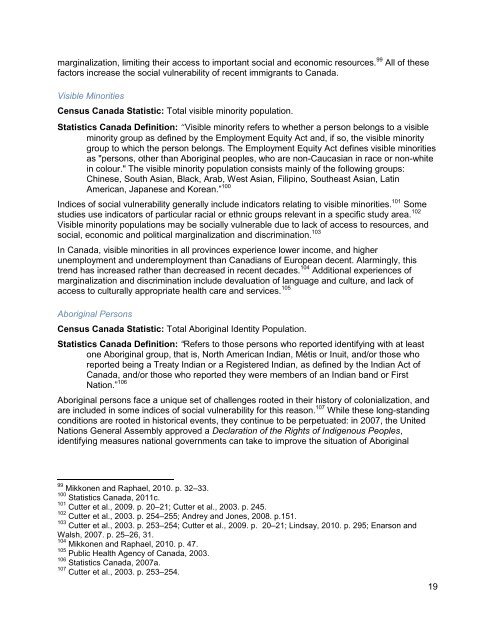Lunenburg Part 2 - Section 5 - Social Vulnerability - August 30.pdf
Lunenburg Part 2 - Section 5 - Social Vulnerability - August 30.pdf
Lunenburg Part 2 - Section 5 - Social Vulnerability - August 30.pdf
You also want an ePaper? Increase the reach of your titles
YUMPU automatically turns print PDFs into web optimized ePapers that Google loves.
marginalization, limiting their access to important social and economic resources. 99 All of these<br />
factors increase the social vulnerability of recent immigrants to Canada.<br />
Visible Minorities<br />
Census Canada Statistic: Total visible minority population.<br />
Statistics Canada Definition: “Visible minority refers to whether a person belongs to a visible<br />
minority group as defined by the Employment Equity Act and, if so, the visible minority<br />
group to which the person belongs. The Employment Equity Act defines visible minorities<br />
as "persons, other than Aboriginal peoples, who are non-Caucasian in race or non-white<br />
in colour." The visible minority population consists mainly of the following groups:<br />
Chinese, South Asian, Black, Arab, West Asian, Filipino, Southeast Asian, Latin<br />
American, Japanese and Korean.” 100<br />
Indices of social vulnerability generally include indicators relating to visible minorities. 101 Some<br />
studies use indicators of particular racial or ethnic groups relevant in a specific study area. 102<br />
Visible minority populations may be socially vulnerable due to lack of access to resources, and<br />
social, economic and political marginalization and discrimination. 103<br />
In Canada, visible minorities in all provinces experience lower income, and higher<br />
unemployment and underemployment than Canadians of European decent. Alarmingly, this<br />
trend has increased rather than decreased in recent decades. 104 Additional experiences of<br />
marginalization and discrimination include devaluation of language and culture, and lack of<br />
access to culturally appropriate health care and services. 105<br />
Aboriginal Persons<br />
Census Canada Statistic: Total Aboriginal Identity Population.<br />
Statistics Canada Definition: “Refers to those persons who reported identifying with at least<br />
one Aboriginal group, that is, North American Indian, Métis or Inuit, and/or those who<br />
reported being a Treaty Indian or a Registered Indian, as defined by the Indian Act of<br />
Canada, and/or those who reported they were members of an Indian band or First<br />
Nation.” 106<br />
Aboriginal persons face a unique set of challenges rooted in their history of colonialization, and<br />
are included in some indices of social vulnerability for this reason. 107 While these long-standing<br />
conditions are rooted in historical events, they continue to be perpetuated: in 2007, the United<br />
Nations General Assembly approved a Declaration of the Rights of Indigenous Peoples,<br />
identifying measures national governments can take to improve the situation of Aboriginal<br />
99 Mikkonen and Raphael, 2010. p. 32–33.<br />
100 Statistics Canada, 2011c.<br />
101 Cutter et al., 2009. p. 20–21; Cutter et al., 2003. p. 245.<br />
102 Cutter et al., 2003. p. 254–255; Andrey and Jones, 2008. p.151.<br />
103 Cutter et al., 2003. p. 253–254; Cutter et al., 2009. p. 20–21; Lindsay, 2010. p. 295; Enarson and<br />
Walsh, 2007. p. 25–26, 31.<br />
104 Mikkonen and Raphael, 2010. p. 47.<br />
105 Public Health Agency of Canada, 2003.<br />
106 Statistics Canada, 2007a.<br />
107 Cutter et al., 2003. p. 253–254.<br />
19














